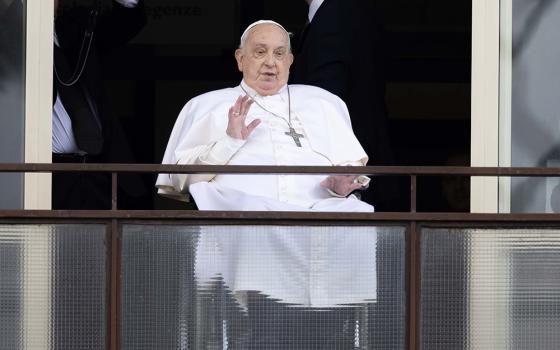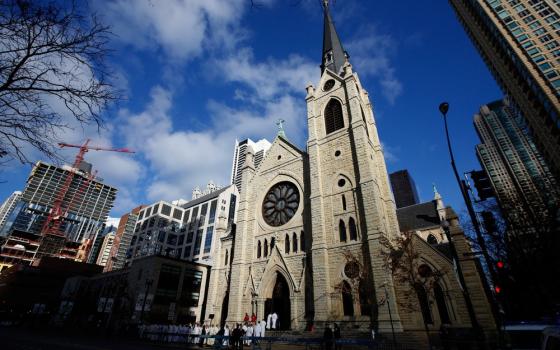The images are awful yet sublime: Fifty thousand men, covered in sludge and grime, swarm like ants in the vast Serra Pelada gold mine in Brazil, scaling rickety ladders forty times a day, and forty times descending again into a pit so steep and slick the only way to reach the bottom safely is to run: if you slow down for just an instant, you’ll tumble headlong into the abyss.
The man who took these Dantean photographs — black and white as though forged out of steel — is Sebastião Salgado, the subject of the arresting new film “The Salt of the Earth” by the acclaimed German director Wim Wenders.
The documentary covers Salgado’s career from his early days photographing Latin American peasants to his more recent work in Africa witnessing mass extinctions of human life.
Salgado traveled to the drought-stricken Sahel, where the Ethiopian Christians he observed wouldn’t cut in front of others in the water line even as their own children died of thirst in their arms. When their children died, these parents used what precious water they had left to wash their little bodies, so they would be clean before God.
“The suffering he witnessed changed him,” narrates Wenders.
Salgado’s natural optimism further disintegrated during the Rwandan genocide and Congo Civil War, as he documented millions upon millions of refugees starving and thirsting to death — when they weren’t being massacred outright.
“What disgusted me the most” during this time, Salgado relates, “was to see how contagious hatred was.”
People around him grew so desensitized to the waste of war that they could throw their own children’s corpses into mass graves and go on chatting with their neighbors as though nothing had happened.
“People were dying like ants,” Salgado says. “How many times I had to put my camera down to weep. My soul was sick. When I left [Rwanda], I no longer believed there was any salvation. No one deserves to live.
"Everybody should see these images,” he concludes, “to see how terrible a species we are. We are ferocious animals.”
Although the film never mentions it, Salgado’s work has received ample criticism. Some claim he is a voyeur exploiting people’s vulnerability, prettifying their suffering with beautifully composed frames and luminous silver tones. Susan Sontag accuses him of depicting the poor only in their “powerlessness,” and of overwhelming us with the spectacle of death to the point that we feel powerless to do anything about it, ourselves.
For me, seeing Salgado’s work was like feeling an old thorn in my side, a thorn that has been lodged there since my own visits to Haiti, Ecuador and El Salvador. It made me want to shake off my complacency, rather than settle further into it. Still, Sontag’s critique about being numbed into resignation is not entirely groundless: overwhelmed by despair, Salgado himself eventually could take no more and gave up his work.
If Salgado has been criticized for being too harsh, too bleak, too unrelenting, one may accuse the gentle Wenders of being too soft, too sentimental, for the film’s ending is basically a happy one. Yet in this, it is true to life.
Inspired by his wife and muse Lelia, an artist in her own right, the exhausted Salgado returned to his father’s drought-depleted farm in Minas Gerais, Brazil. He and Lelia reforested the land, planting over two and a half million trees, and eventually created a major non-profit devoted to ecological sustainability and regrowth. His own spirit renewed, Salgado returned to photography, now chronicling pristine ecosystems all over the world — as well as the resilient, primitive peoples who live in harmony with them — in a new project entitled “Genesis.”
Anyone who has worked among the very poor knows how hard it is to strike a solid stance between reality-denying optimism and hope-destroying despair. In depicting the whole arc of Salgado’s life, the film depicts this tension too. I don’t think Wenders’s unironic portrayal of the artist’s spiritual rebirth is meant to dismiss the prevalence of pain and evil in our world, so much as to suggest that the proper response to suffering goes beyond making a definitive, nihilistic statement about it. The proper response is precisely to create, just as God created in Genesis: in order that creation be good, not because it was already good.
As John of the Cross put it: Where there is no love, put love, and you will draw out love.
Salgado, though a friend of priests and liberation theologians, is not himself a believer; he is the sort of unsentimental friend of humanity that Camus would call a “saint without God.”
Wenders, on the other hand, is Christian, an “eternal optimist” who claims that cynicism is among the worst sins an artist can commit. Indeed, the eponymous judgment that human beings are “the salt of the earth” is Wenders’s, not Salgado’s — though that conviction ultimately shines, unspoken, in the Brazilian photographer’s face, as in his work.
One thing I took from the film is that with each of us implicitly seeking reasons to believe that our tentative faith in the goodness of reality is not completely baseless, everything we do, like it or not, ultimately becomes a metaphor. Whether we are artists or gardeners or something else, our work can always strike others as a sign either of humanity’s innate greed and depravity, or of the possibility of cooperation and self-transcendence. We should all conduct our work, and our lives, with Salgado’s dignity, sincerity, and creativity.
Late in the film, the artist discovers the calcified carapace of a cicada’s corpse clinging to one of his trees. Gummed by the spit of hundreds of termites crawling around it, it has become almost one with the bark. “It sang until it died,” Salgado says of the insect.
How’s that for a metaphor?
This film is currently playing in select theaters.




